I need one or more hints to get over the first pain in transfer-learning.
The following code is a stripped-down version of what I am actually trying to do, but it shows the issues even with one the fake image (A: empty / B: empty + little square) I use there. In the final version, the input will be much more complex images (which justifies the complexity of the applied base model).
The problem looks simple. Input: two types of images, output: binary classification ("square present yes/no"). The modified ResNet50 model is fed with prepared training data via ImageDataGenerator. As I can create any amount of fake data, there is no data augmentation step in the code.
Anyway, when I run the code the displayed loss (for both the Adam and the SDG optimizer) doesn't seem to improve and the accuracy quickly tends to approach the ratio of the number of the examples in the two image classes (i.e. B/A). (Note: during the weekend, I even tried for 500 epochs ... no change.)
For both (most likely connected) issues I haven't been able to spot the reason yet ... could you? Is it one of the hyper-parameters, is there an obvious glitch in the model setup or any other part of the implementation? Probably it's just something stupid, but after chasing it and playing around with different and more and more simplified versions, I am about to run out of ideas regarding what to try next.
import cv2
import matplotlib.pyplot as plt
import numpy as np
from tqdm import tqdm
from random import randint
from keras.layers import Dense, GlobalAveragePooling2D
from keras.optimizers import Adam
from keras.models import Model
from keras.applications import ResNet50
from keras.preprocessing.image import ImageDataGenerator
def modified_resnet_model():
# load ResNet50 model excluding classification layers
basemodel = ResNet50(weights='imagenet', include_top=False, input_shape=(224, 224, 3))
# freeze model weights
for layer in basemodel.layers:
layer.trainable = False
# add new classification head
x = GlobalAveragePooling2D()(basemodel.output)
x = Dense(128, activation='relu')(x)
predictions = Dense(1, activation='softmax')(x)
modresnet50model = Model(inputs=basemodel.input, outputs=predictions)
# return the result
return modresnet50model
def data_set_creator(numsamples, probpos, target_image_size=(224, 224)):
dataset = {}
image_stack = []
immean = np.array([0.0, 0.0, 0.0])
imstat = {}
# first create target labels
lbbuf = np.zeros((numsamples, 1))
lbbuf[:int(probpos*numsamples)] = 1
lbbuf = np.random.permutation(lbbuf)
# second create matching "fake" images according to label stack
for index in tqdm(range(numsamples)):
# zero labeled images are empty
img = np.zeros((target_image_size[0], target_image_size[1], 3)).astype(np.float32)
sh = 10
if lbbuf[index]:
# all others contain a suqare somewhere
xp = randint(sh, target_image_size[0]-1-sh)
yp = randint(sh, target_image_size[1]-1-sh)
randval = 100 # randint(1, 255)
# print('center: ({0:d},{1:d}); value: {2:d}'.format(xp, yp, randval))
img[yp-sh:yp+sh, xp-sh:xp+sh, :] = randval
# else:
# print(' --- ')
# normalize image and add it to the image stack
img /= 255.0 # normalize image
image_stack.append(img)
# update mean vector
immean += cv2.mean(img)[:-1]
# assemple data set
imstat['mean'] = immean/numsamples
image_stack = np.array(image_stack)
dataset['images'] = image_stack
dataset['imstat'] = imstat
dataset['labels'] = lbbuf
# return the result
return dataset
if __name__ == '__main__':
# define some parameters
imagesize = (224, 224)
nsamples = 10000
pos_prob_train = 0.3
probposval = pos_prob_train
valfrac = 0.1 # use 10% of the data for validation
batchsize = 24
epochs = 30
stepsperepoch = 100
validationsteps = 25
# ================================================================================
# create training and validation data sets
nst = int(nsamples*(1-valfrac))
dataset_training = data_set_creator(nst, pos_prob_train, target_image_size=imagesize)
dataset_validation = data_set_creator(nsamples-nst, probposval, target_image_size=imagesize)
# subtract the mean (training data!) from all the images
for ci in range(3):
dataset_training['images'][:, :, :, ci] -= dataset_training['imstat']['mean'][ci]
dataset_validation['images'][:, :, :, ci] -= dataset_training['imstat']['mean'][ci]
# get the (modified) model
model = modified_resnet_model()
theoptimizer = Adam(lr=0.001, beta_1=0.9, beta_2=0.999, epsilon=1e-8)
model.compile(optimizer=theoptimizer, loss='binary_crossentropy', metrics=['accuracy'])
print(model.summary())
# setup data input generators
train_datagen = ImageDataGenerator()
validation_datagen = ImageDataGenerator()
train_generator = train_datagen.flow(dataset_training['images'],
dataset_training['labels'],
batch_size=batchsize)
validation_generator = validation_datagen.flow(dataset_validation['images'],
dataset_validation['labels'],
batch_size=batchsize)
# train the (modified) model
history = model.fit_generator(train_generator, steps_per_epoch=stepsperepoch,
epochs=epochs, validation_data=validation_generator,
validation_steps=validationsteps)
#visualize the training and validation performance
acc = history.history['acc']
val_acc = history.history['val_acc']
loss = history.history['loss']
val_loss = history.history['val_loss']
nepochs = range(1, len(acc)+1)
plt.plot(nepochs, acc, 'bo', label='Training acc')
plt.plot(nepochs, val_acc, 'b', label='Validation acc')
plt.title('Training and validation accuracy')
plt.legend()
plt.savefig('trainval_acc.png')
plt.figure()
plt.plot(nepochs, loss, 'bo', label='Training loss')
plt.plot(nepochs, val_loss, 'b', label='Validation loss')
plt.title('Training and validation loss')
plt.legend()
plt.savefig('trainval_loss.png')
plt.show()
